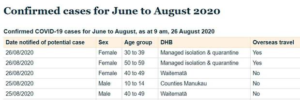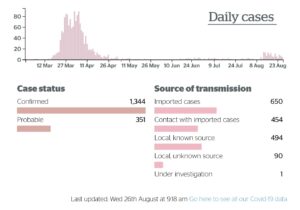New Zealand has five new cases of Covid-19 today and a new potential “mini-cluster” has been identified.
There are three new community cases, one of which is under investigation.
Two cases are imported cases – a female in her 50s and a man in his 30s. They have been transferred to the Jet Park Hotel.
It takes the country’s number of active cases to 134 – 21 of those are imports from overseas, and 108 are linked to the Auckland cluster, which is New Zealand’s largest cluster to date.
Wearing masks
Hipkins said secondary school students will need to wear masks on school buses from Monday, but younger students won’t have to. The age cut-off for wearing masks is still being worked through.
Prime Minister Jacinda Ardern announced on Monday that masks would be mandatory on public transport from Monday, August 31.
Asked about the supply of masks to Maori and Pasifika communities, Hipkins said three millions masks had been distributed and the government was working with supermarkets to ensure they had a good supply of masks.
He added that surgical masks were not necessary and people could have a cloth mask such as a bandana.
Testing ramped up
This week the Health Ministry wants to conduct 10,000 tests a day, 70 per cent of them in South and West Auckland to reveal more about the prevalence of Covid-19 in those areas.
There were 8559 tests conducted yesterday, short of the 10,000 a day that the government is aiming for this week.
Mobile and pop-up testing sites are set up today and tomorrow at Ranui library carpark, Randwick Park School, Mt Smart Stadium and Takahemonu Methodist Church.
Bloomfield encouraged people with or without symptoms to get tested, which will shed more light on the prevalence of the virus in South and West Auckland.
Bloomfield said the pop-up testing stations were in places to ensure those populations in South and West Auckland had access to testing.
Discussions were being had with DHBs and within the ministry to encourage people to get tested, he said.
“I would encourage them to seek a test.”
He said he thought people would show up to get tested, and he had written to DHB bosses and given a clear directive to provide access to testing. The ministry wants to conduct 10,000 tests a day.
Asked about empty testing stations around Auckland, Bloomfield believed people would get tested if they knew there was access to testing.
In Queenstown, for example, a pop-up station led to more than 1000 people getting tested.
“I don’t have any sense there will be lack of willingness to be tested.”
Hipkins said there were 1021 places to get tested, 350 of which are in the Auckland metropolitan area.
“We do have the ability as the week progresses to pop up new sites.”
He said the Government will not use any Covid testing information for immigration decisions, so people who have overstayed their visas should not be worried about testing positive and being chased up officials.
Testing of people in managed isolation
People are meant to be tested on day three and day 12 of their stay in managed isolation, and to date there have been 20,065 day three tests and 19,473 day 12 tests.
The difference in the numbers is a reflection of people who have been tested on day three but are yet to be tested on day 12. There are currently 5204 people in managed isolation or quarantine.
There have been 14 positive tests on day 12, all but two of whom had tested negative on day three.
“This should give the community confidence that no one is coming out of managed isolation or quarantine without a clean bill of health,” Hipkins said.
He said 15 people had refused a day 12 test, and their stay in managed isolation was extended because of that.
He did not know how many people had refused a day three test.
“Day three we do not test absolutely everybody. We do not routinely test very young children.”
He was not worried about the day three tests because people in managed isolation weren’t allowed to leave after 14 days if they didn’t test positive on their day 12 test.
QR codes
There are now more than 1,834,000 people registered to use the NZ Covid Tracer app.
Hipkins said QR codes will be mandatory on buses, trains, taxis, ferries and rideshare vehicles from Friday next week. Private vehicles will be exempt. Drivers will not be asked to ensure passengers scan the QR codes.
He said it would provide an extra layer of assurance and speed for contact tracing.
He said it was faster to get in touch with people if they used the Covid Tracer app, which was also more useful than Hop or Snapper cards.
Hipkins said the global pandemic was still growing rapidly overseas, so managing Covid-19 at the border, including regular testing, remained important.
New health group
Hipkins revealed more people on the group co-chaired by Heather Simpson and Sir Brian Roche to oversee the testing strategy.
He said the group would focus on ensuring cases are quickly identified, identifying and minimising undetected community spread, having equitable access to testing for Maori and Pasifika, and ensuring high-risk people, such as some border-facing workers were being regularly tested.
Members of the group, announced today, are:
• Dr Api Talemaitoga – GP, chair of NZ College of GPs Pacific Chapter.
• Dr Rawiri Jansen – GP, Papakura and Clinical Director of the National Hauora Coalition.
• Professor Philip Hill – McAuley Professor of International Health and Director of the Centre for International Health at the University of Otago.
NCEA
Hipkins rejected Maori Party co-leader John Tamihere’s call for all NCEA students to given a pass mark this year.

Director general of health Ashley Bloomfield and Health Minister Chris Hipkins have provided the latest Covid-19 update.
Bloomfield said five people associated with the Mt Roskill Evangelical Fellowship Church have been diagnosed with Covid-19 in the last two to three days.
People who were at services at the church on Stoddard Rd on August 8, 9 and 11 or at a wedding there on Friday, August 7, should get tested as soon as possible.
Bloomfield said these cases were not yet linked to the existing Auckland cluster, so they were currently being treated as a “mini-cluster”.
He said he expected the cases will eventually be to be linked to the cluster, but an epidemiological link was yet to be established.
Genomic sequencing is underway.
There are 163 people linked to the cluster in quarantine, including 90 people who have tested positive.
Nine people are in hospital with Covid-19 – three patients in a critical condition. Two patients are in Auckland City Hospital in a stable condition, three at North Shore Hospital and four at Middlemore Hospital.
One of the cases at North Shore Hospital is also under investigation. The person has a strain that is linked to the cluster via genomic sequencing, but it is still unknown who he caught the virus from.
None of their close contacts from their household or workplace have tested positive.
The man went to a private function at the start of August, which is being looked at as a possible source of infection.
Auckland is in alert level 3 until 11.59pm on Sunday, when it will move to a tighter level 2 with a 10-person limit on social gatherings.
The rest of the country is at normal level 2, where there is a 100-person limit on social gatherings.



Leave A Comment